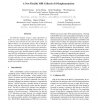Free Online Productivity Tools
i2Speak
i2Symbol
i2OCR
iTex2Img
iWeb2Print
iWeb2Shot
i2Type
iPdf2Split
iPdf2Merge
i2Bopomofo
i2Arabic
i2Style
i2Image
i2PDF
iLatex2Rtf
Sci2ools
CLUSTER
2006
IEEE
2006
IEEE
A New Flexible MPI Collective I/O Implementation
The MPI-IO standard creates a huge opportunity to break out of the traditional file system I/O methods. As a software layer between the user and the file system, an MPI-IO library can potentially optimize I/O on behalf of the user with little to no user intervention. This is all possible because of the rich data description and communication infrastructure MPI-2 offers. Powerful data descriptions and some of the other desirable features of MPI-2, however, make MPI-IO challenging to implement. By creating a new collective I/O implementation that allows developers to easily tinker and play with new optimizations or combinations of different techniques, research can proceed faster and be quickly and reliably deployed.
CLUSTER 2006 | Cluster Computing | Communication Infrastructure Mpi-2 | Data Descriptions | I/O Methods |
| Added | 10 Jun 2010 |
| Updated | 10 Jun 2010 |
| Type | Conference |
| Year | 2006 |
| Where | CLUSTER |
| Authors | Kenin Coloma, Avery Ching, Alok N. Choudhary, Wei-keng Liao, Robert B. Ross, Rajeev Thakur, Lee Ward |
Comments (0)

